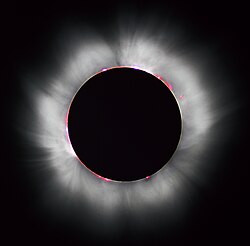
Back Plasma (fisika) Afrikaans Plasma (Physik) ALS Plasma (fisica) AN प्लाज्मा ANP بلازما (فيزياء) Arabic بلازما (فيزيا) ARZ প্লাজমা Assamese Plasma (estáu de la materia) AST Plazma Azerbaijani پلاسما AZB
Plasma (from Ancient Greek πλάσμα (plásma) 'moldable substance')[1] is a state of matter that results from a gaseous state having undergone some degree of ionisation. It thus consists of a significant portion of charged particles (ions and/or electrons). While rarely encountered on Earth, it is estimated that 99.9% of all ordinary matter in the universe is plasma[2]. Stars are almost pure balls of plasma, and plasma dominates the rarefied intracluster medium and intergalactic medium.[3][4][5][6] Plasma can be artificially generated, for example, by heating a neutral gas or subjecting it to a strong electromagnetic field.[7]
The presence of charged particles makes plasma electrically conductive, with the dynamics of individual particles and macroscopic plasma motion governed by collective electromagnetic fields and very sensitive to externally applied fields.[8] The response of plasma to electromagnetic fields is used in many modern devices and technologies, such as plasma televisions or plasma etching.[9]
Depending on temperature and density, a certain number of neutral particles may also be present, in which case plasma is called partially ionized. Neon signs and lightning are examples of partially ionized plasmas.[10]
Unlike the phase transitions between the other three states of matter, the transition to plasma is not well defined and is a matter of interpretation and context.[11] Whether a given degree of ionization suffices to call a substance "plasma" depends on the specific phenomenon being considered.
- ^ Liddell, Henry George; Scott, Robert (1940). "πλάσμα". A Greek-English Lexicon. Clarendon Press. Retrieved 10 February 2023.
- ^ "Plasma, Plasma, Everywhere!". nasa. Retrieved 23 June 2025.
- ^ Chu, P.K.; Lu, XinPel (2013). Low Temperature Plasma Technology: Methods and Applications. CRC Press. p. 3. ISBN 978-1-4665-0990-0.
- ^ Piel, A. (2010). Plasma Physics: An Introduction to Laboratory, Space, and Fusion Plasmas. Springer. pp. 4–5. ISBN 978-3-642-10491-6. Archived from the original on 5 January 2016.
- ^ Phillips, K. J. H. (1995). Guide to the Sun. Cambridge University Press. p. 295. ISBN 978-0-521-39788-9. Archived from the original on 15 January 2018.
- ^ Aschwanden, M. J. (2004). Physics of the Solar Corona. An Introduction. Praxis Publishing. ISBN 978-3-540-22321-4.
- ^ Chiuderi, C.; Velli, M. (2015). Basics of Plasma Astrophysics. Springer. p. 17. ISBN 978-88-470-5280-2.
- ^ Morozov, A.I. (2012). Introduction to Plasma Dynamics. CRC Press. p. 30. ISBN 978-1-4398-8132-3.
- ^ Chu, P.K.; Lu, XinPel (2013). Low Temperature Plasma Technology: Methods and Applications. CRC Press. ISBN 978-1-4665-0990-0.
- ^ "How Lightning Works". HowStuffWorks. April 2000. Archived from the original on 7 April 2014.
- ^ Morozov, A.I. (2012). Introduction to Plasma Dynamics. CRC Press. p. 4−5. ISBN 978-1-4398-8132-3.
© MMXXIII Rich X Search. We shall prevail. All rights reserved. Rich X Search





